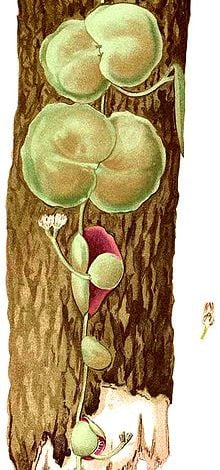Dischidia

Dischidia is a genus of plants in the family Apocynaceae. They are epiphytes native to tropical areas of China, India and most areas of Indo-China. Dischidia are closely aligned with the sister genus Hoya. Unlike Hoya, the genus Dischidia is poorly known and has not been studied as closely.
Most Dischidia grow in arboreal ant nests of different species and some have developed a symbiotic relationship where the plant has developed modified leaves to either provide housing or storage. Of these there are two types of modification to the leaves. Three species develop bullate leaves which are hollow root-filled structures. These are Dischidia complex Griff, Dischidia major (Vahl) Merr. and Dischidia vidalii Becc. Both produce normal leaves (cordate in shape) in addition to the bullate leaves. These bullate leaves are formed when the outer margins of a leaf stop growing while the center of the leaf continues to grow. As time progresses the leaf margins curl under to close the gap which creates a small hole.[2]
A number of species develop imbricate leaves which hold tightly to the growing surface. The underside of the leaf has a space which is filled with roots that the ants take advantage of. Examples of these species are Dischidia major, Dischidia astephana, Dichidia imbricata and Dischidia platyphylla, but there are many more. Plants with this type of growth habit are sometimes called Shingle Plants, which are given this name because the leaves tend to overlap as the grow up or down the surface and give the appearance of shingles on a roof.[3]
A few of the species in widespread cultivation.
